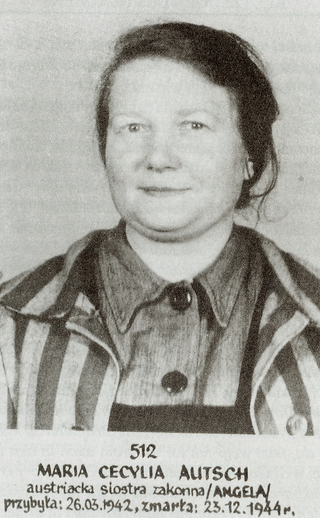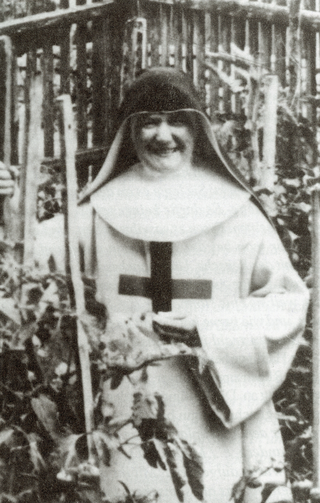Schwester Angela Maria (Maria Cäcilia, „Engel von Auschwitz“) Autsch OSST

Personalia
Order Name:
Born:
Died:
Profession:
Persecution:
Imprisonment 12.08.1940 - 29.08.1940,
Ravensbrück concentration camp 29.08.1940 - 26.03.1942,
Auschwitz concentration camp 26.03.1942 - 23.12.1944,
Murdered 23.12.1944
KZ Number:
Curriculum Vitae
Maria Cäcilia Autsch is born in Röllecken in Westphalia (Germany) as the fifth of seven children of August Autsch, a Catholic machinist from the Siegerland region. Her father worked in a limestone quarry to support his large family. Like her husband, her mother, Amalia Autsch, née Schmidt, was strongly religious and instilled a strict Catholic attitude in her children.
In 1930, Maria Cäcilia Autsch leaves the fashion store where she works and moves to Heinsberg, where she supports her brother in his general store. During a pilgrimage to Trier in 1933, she met the sisters of the Institute of the Sisters of the Most Holy Trinity (Trinitarians). A companion during this phase is the parish priest of Heinsberg, who is already a staunch opponent of National Socialism. That same year, on September 27, 1933, she entered the convent of the Trinitarian Congregation of Valencia in Mötz in Tyrol. The convent in Mötz (Tyrol) has existed since 1926 following a donation of land by Countess Sarolta Erdödy; the first nuns of the Valencian Trinitarian order to come to Austria were Spanish. The aim of the sisters is to alleviate the fate of people in captivity. They work in nursing, education and in the service of liberation from all forms of slavery.

After the National Socialists seize power in Austria, they attempt to confiscate the convent in Mötz. Sister Angela saves the convent by making a compelling legal argument that it is Spanish property. She contacts the Spanish consul in Vienna and enters into correspondence with him, which ultimately leads to the National Socialists shying away from expropriating the convent in order to avoid international entanglements. These activities drew the Gestapo's evil eye to Sister Angela; however, the immediate reason for her arrest lay in her critical remarks about Adolf Hitler.
"With deep reverence and gratitude, I think of Mary, who never complained. She had understanding for every human being and became our helper and comforter in this terrible, unrepeatable time. Mary remains engraved in our hearts. Even now, so long later, her memory gives me strength in every situation."
In a store near the convent, Sister Angela tells of the sinking of a German ship in Norway - a fact that was kept secret and could only have become known through listening to "enemy broadcasts". On August 12, 1940, Sister Angela was arrested by the Gestapo on the basis of an anonymous denunciation and taken to the Innsbruck police detention center, where, as eyewitnesses would later report, she was subjected to extremely brutal treatment. The official reasons given for her arrest were "insulting the Führer" and "inciting the population". All attempts by her fellow sisters to secure Sister Angela's release were unsuccessful. The Mother Superior contacted the Gestapo in person several times and urgently asked the Autsch family to write petitions for clemency; even contacting the Spanish consul again could not save Sister Angela. Without a trial, she was deported to the Women's Concentration Camp Ravensbrück on August 29, 1940, where she arrived on August 31, 1940. With the prisoner number 4651, she was marked with the red corner of political prisoners.
"On the day I was brought in, I was wearing wooden shoes and an old Russian uniform without buttons and was shaved bald. I went for days without food or water. When she saw me, she came up to me and stroked my shaved head. It was so touching that, as a half-human, someone came up to me and stroked my head."
On March 26, 1942, Sister Angela was transferred to the Auschwitz concentration camp
Places
Place of activity:
Death Place:
Persecution:
Citations
- Homepage von "biografiA" unter www.biografia.sabiado.at
- Mikrut, Jan (1999): Blutzeugen des Glaubens. Martyrologium des 20. Jahrhunderts (Wien), p. 25–44.
